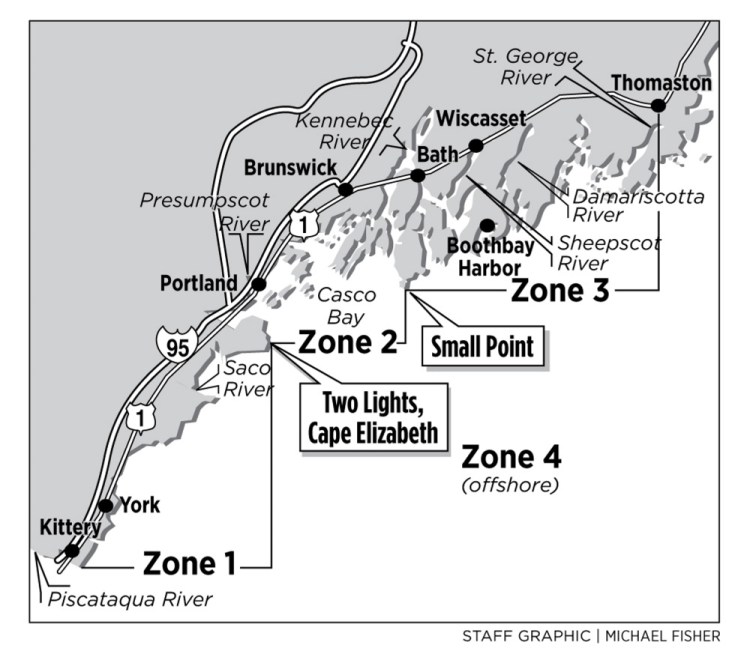If you are a recreational saltwater angler, Maine law may require you to register with the Maine Saltwater Recreational Fishing Registry. To learn more or to register, visit maine.gov/saltwater or call 633-9505.
OFFSHORE:
Finally, the National Marine Fisheries Service has set the 2017 recreational groundfish regulations. This means anglers can keep 12 haddock (instead of 15) a day that are over 17 inches, but may not retain any cod this year. The minimum size for halibut in federal waters is 41 inches and the taking of halibut in Maine territorial waters is closed from July 1 to April 30. During last week’s Bailey Island tourney, 35 tuna were entered with a 650-pounder taking first. The 20th annual Sturdivant Island tuna tournament, based out of Spring Point marina in South Portland, starts Thursday and runs through Saturday. It’s a highly competitive, no-nonsense event that draws the region’s top tuna men. Sharking will be picking up for those targeting blue sharks and there have been reports of decent makos and threshers taken. The minimum size for all keeper sharks (makos, porbeagles, threshers and blues) is 4.5 feet in length while basking and white sharks are federally protected. All vessels fishing recreationally for Atlantic tuna, sharks, swordfish and billfish must have an Atlantic HMS angling permit. For more information contact the NMFS at 978-281-9260 or visit their website. Groundfishing remains steady on Tanta’s, Jeffrey’s, Platt’s and the Trinidad. Anglers can expect to catch mostly pollock, haddock and cod (which must be released). Sea surface temperature reports from the Jeffrey’s Ledge buoy show temps in the high 60s touching 70 while at the Portland LNB weather buoy temperatures are in the low to mid 60s.
COASTAL
Federal striped bass regulations: It’s unlawful to fish for, take or possess striped bass in federal waters (waters greater than three miles from shore).
Statewide striped bass regulations: An angler may fish all year for striped bass but may only keep one per day that measures over 28 inches. If you have any questions or would like copies of the saltwater regulations, call 633-9505 or check the web.
ZONE 1: Stripers of all sizes are around in fishable numbers. Some spots that have been productive include the Camp Ellis jetty (both sides), the Wells jetty, Pine Point, Goosefare Brook and Old Orchard Beach. Beach fishermen should check local ordinances; some area beaches may restrict fishing between 9 a.m. and 5 p.m. Even though we are into August, there are fish in the rivers. Anglers fishing the lower rivers on an outgoing tide have had the best luck using sandworm or pogies. Mackerel, worms and clams are the preferred baits. Rubber baits (Storm Wild Eye, Shanka’s, RonZ) have been getting fish for the crank fishermen while those throwing flies that resemble natural bait (sand eel, crab patterns) are also catching fish. Mackerel catching remains spotty but anglers should work the traditional spots (Richmond, Wood, Stratton, Bluff islands, etc.). A few bluefish have been reported so keep that wire leader handy just in case.
ZONE 2: With the continuation of warm weather, striper activity out around the ledges, the Cape shore and islands is better than inside. There are stripers around but they have been finicky due to the abundance of bait. Anglers should fish early or late for the best results. Bait fishermen have been doing well with chunk macs and sandworms. The water temperature inside Portland Harbor remains around 60 degrees.
ZONE 3: Stripers are around in decent numbers. Anglers should look for and fish areas of moving water and bird activity. There’s a lot of bait around so you may see these fish but can’t get one to take your hook. Bloodworms bounced along the bottom off the beaches will get fish as will eels, clams and chunk macs. Those fishing the rivers should fish deep and during the early morning or just after sunset. If you choose to work artificials, try Creek Chub poppers, the 4½- to 5½-inch flecked Slug-Gos or the traditional Bucktails and Kastmasters. Mackerel continue to be caught in all their traditional spots, all the way to Eastport. Anglers have had success using Sabiki rigs and chum (cat food) to get on and keep on these fish. Remember that if you are fishing on the Kennebec, upstream of the power line in Augusta, you must have a current freshwater fishing license.
This saltwater report is compiled by Bruce Joule, Maine Department of Marine Resources, P.O. Box 8, West Boothbay Harbor 04575. If you have information to report please contact me at 633-9505 or
E-Mail: bruce.joule@maine.gov
Send questions/comments to the editors.


